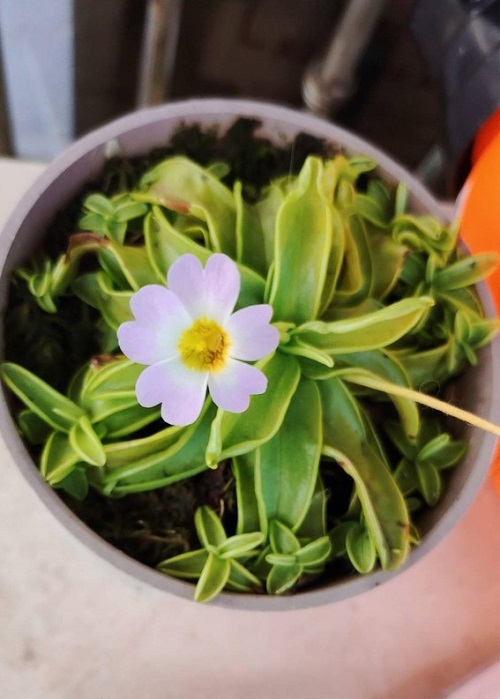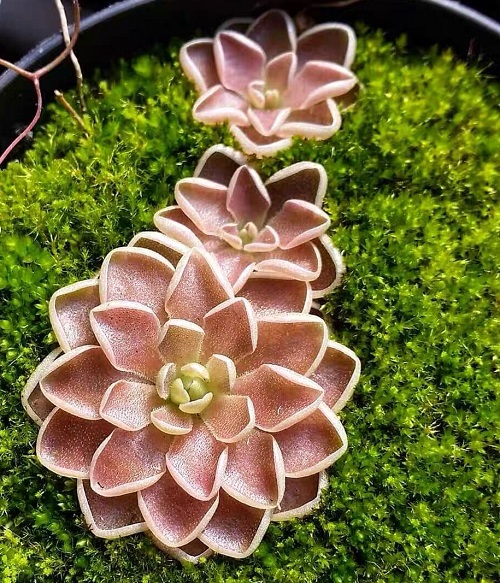If you want a plant with botanical elegance and carnivorous intrigue, then keep on reading to know about Growing Butterwort!
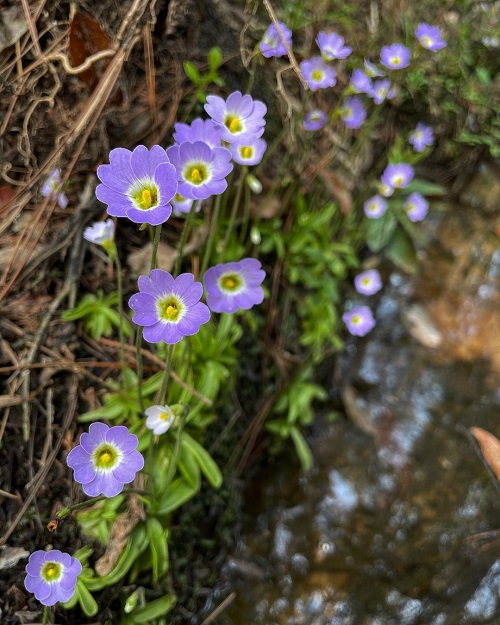
Nature’s marvels often come in unexpected forms, and butterwort plants (Pinguicula spp.) are a testament to this. These captivating botanical wonders are visually appealing and boast a fascinating insect-trapping mechanism. This article will delve into growing Butterwort, uncovering its secrets, and providing insights!
Botanical Name: Pinguicula spp.
Common Names: Bog violet, Marsh violet, or Pings
USDA Hardiness Zones: 8-9
Check Out Indoor Carnivorous Plants For Beginners Here
Butterwort Plant Information
Butterwort showcases an astonishing range of sizes, colors, and shapes that make them stand out in any botanical collection. From diminutive one-inch plants to more substantial 18-inch specimens, Butterwort offers a visual feast of white, pink, maroon, green, and yellow hues.
Classifying under the Pinguicula genus within the Lentibulariaceae family, butterworts represent a group of plants encompassing over 80 species. Their natural habitats span various continents, excluding Australia and Antarctica.
Depending on their origin, Butterwort can be categorized as temperate, warm temperate, or tropical, each requiring specific care to ensure their successful growth. The Butterwort plant employs a fascinating insect-trapping strategy. Its leaves are covered in a glistening, sticky substance that lures insects. Once an insect lands on the leaves, they become ensnared in the adhesive secretions. The plant then gradually curls its leaf edges, encasing the prey and initiating the process of digestion.
Butterwort Plant Propagation

You can expand your Butterwort collection through two distinct propagation techniques: leaf pullings and offsets. By mastering these methods with the help of our guide, you can multiply your plants while enjoying the rewarding experience of nurturing new specimens.
Leaf:
- Choose mature, undamaged leaves from the Butterwort plant for propagation.
- Put the leaf on the preferred growing medium within a seed-starting tray.
- Provide consistent lighting, moisture, and temperature levels akin to seed germination.
- Over time, buds and roots will emerge, signaling successful propagation.
- Once a second set of leaves develops, remove the humidity cover for continued growth.
- After several months, transfer each cutting to its individual container for ongoing care.
Propagate Any Plant Cutting Quickly Using this Trick
Offsets:
- During dormancy, identify clumping sprouts (offsets) on your Butterwort plant.
- Carefully cut the offset or pups from the parent plant using a sterilized blade.
- Position the offset with their pointed ends upward within the chosen growing medium.
- Maintain warm and humid conditions, allowing the offset to root and flourish.
- Follow standard care practices, tailoring them to the needs of each species.
When to Plant Butterwort
Timing is crucial when it comes to planting Butterwort as it ensures their robust growth and flourishing health. The ideal months for planting Butterwort are typically during the spring and early summer. This period provides the plants with the optimal conditions to establish themselves successfully.
Spring and early summer offer moderate temperatures conducive to your butterwort growth. The plants thrive in the range of 60 to 85°F (15 to 29°C), making these months ideal for their introduction to your garden or indoor space.
Longer daylight hours in these months will also provide butterworts with the necessary light intensity for photosynthesis and overall vitality.
Butterwort Plant Ideal Pot Size
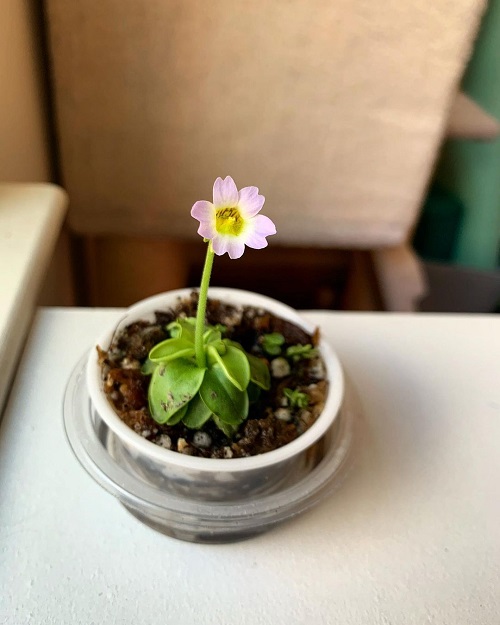
Selecting the correct pot size lays the foundation for successful Butterwort growth. Opt for a pot 3 to 4 inches in diameter, especially if growing a temperate, warm temperate, or tropical species.
Ensure the pot offers ample room for the root system to develop within the chosen potting mix. Choose pots made from plastic or ceramic, each equipped with drainage holes to manage moisture levels effectively.
Here are Plant Pot Sizes from Inches to Gallon
Requirements for Growing Butterwort Plants

Light
Butterwort thrives in bright, indirect light. Place them in a location that receives filtered sunlight, such as near east or west-facing windows.
If you’re growing Butterwort indoors, consider using artificial grow lights with a spectrum suitable for plant growth. Avoid exposing them to intense, direct sunlight, as it can scorch their leaves.
Soil
Selecting the right soil mix is vital for Butterwort growth. You can either buy a commercial soil mix particularly made for carnivorous plants or prepare one yourself.
A recommended mix includes a combination of peat moss, or coco coir, perlite, and sand. This mixture ensures proper drainage and aeration for the plant’s root system. Here are some of the best homemade soil and potting mixes suitable for Butterwort plants:
1. Peat and Sand Mix
- 1 part peat moss (sphagnum) or coco coir
- 1 part silica sand (washed and free of minerals)
This mix offers good aeration and retains moisture without becoming waterlogged. The lack of nutrients in the sand complements the nutrient-poor nature of peat, making this mix suitable for Butterwort plants.
2. Peat and Perlite Mix
- 1 part peat moss or coco coir
- 1 part perlite
Perlite adds excellent drainage and aeration to the peat, helping to avoid root rot. It’s essential to ensure that the perlite is free from added fertilizers.
3. Pure Long-Fibered Sphagnum Moss
- 100% long-fibered sphagnum moss
Long-fibered sphagnum moss provides excellent moisture retention while still allowing air to the roots. It’s often used alone for Butterwort plants.
4. Peat, Sand, and Perlite Mix
- 1 part peat moss or coco coir
- 1 part silica sand
- 1 part perlite
This mix combines the benefits of both sand and perlite with peat moss, ensuring good aeration, drainage, and moisture retention.
Check Out Carnivorous Plant Terrarium Ideas Here
Important Considerations
- Avoid Garden Soil and Compost: These typically contain too many nutrients and may have a pH that’s not suitable for Butterwort plants.
- Water Quality: Always use distilled water, rainwater, or reverse osmosis water when moistening the soil mix, as tap water may contain harmful minerals.
- Potting Container: Choose a container with drainage holes to prevent waterlogging.
- Acidity: Butterwort plants prefer slightly acidic soil. If possible, test the pH to ensure it’s around 5.0 to 6.0.
Water
Proper watering practices are crucial to prevent water-related issues such as root rot. Water your Butterwort from the bottom by placing the pots in a saucer of filtered or rainwater.
This method prevents minerals and salts from accumulating on the leaves, which can damage sensitive surfaces.
Keep the soil consistently moist, but avoid waterlogging and allow the top inch of the soil to dry slightly before watering again.
Temperature and Humidity
Maintaining suitable temperatures is essential for Butterwort growth and health. Aim for a temperature range of 60 to 85°F (15 to 29°C) during the active growing season.
It’s crucial to avoid prolonged exposure to temperatures below 50°F (10°C) as it can hinder their growth. Butterwort becomes stressed and less active when subjected to temperatures exceeding 90°F (32°C), and it can disrupt their natural processes and cause wilting, so a balance in temperature is a must.
High humidity levels benefit Butterwort as it mimics their natural habitats. If you’re growing butterworts indoors, consider using a humidity tray filled with water or placing a small humidifier nearby.
This ensures that the plants receive the moisture they need, which is especially important for their carnivorous mechanisms to function effectively.
Butterwort Care
Fertilizer
Butterwort plants are carnivorous plants that naturally obtain their nutrients by trapping and digesting small insects. They often grow in nutrient-poor soils and have developed insect-eating abilities to compensate for the lack of nutrients.
Feeding Butterwort Plants
- Natural Feeding (Insects): Butterwort plants generally don’t need additional feeding if they’re outdoors, as they’ll catch insects like gnats and aphids on their own.
- Indoor Feeding: If you’re growing them indoors, you can occasionally feed them tiny insects like fruit flies or small bloodworms.
- Avoid Overfeeding: Overfeeding can cause Butterwort leaves to rot. Make sure not to overfeed them, especially if they are catching insects on their own.
Homemade Fertilizers
- Rainwater or Distilled Water Soaking: Butterworts are sensitive to minerals. A gentle soaking of the leaves with rainwater or distilled water can help the plant obtain needed nutrients without using traditional fertilizers.
- Diluted Orchid Fertilizer: Some growers use a very dilute solution of orchid fertilizer. This can be sprayed sparingly on the leaves, but it must be diluted much more than what is typically recommended for orchids.
Pruning
Regular pruning helps maintain the health and appearance of Butterwort plants. By selectively removing spent blooms, damaged leaves, or any deceased plant components, you actively contribute to the overall well-being of your plant.
Utilizing clean and sterilized pruning shears or scissors is crucial, as it prevents the inadvertent spread of diseases.
Proper pruning will maintain the butterwort’s distinctive features and optimize its performance in capturing prey.
Pests and Diseases
Aphids and slugs, common pests, can hinder the growth of Butterwort. Applying a mild soap-water solution can help eradicate them. Slugs can be curtailed with copper tape barriers and beer traps that attract and eliminate them.
Best Organic Pest Control Approaches Every Gardener Should Know
Gray mold, Botrytis, and other common pests thrive in humidity and can affect Butterwort plant. To prevent this disease, prioritize air circulation, avoid overhead watering, and promptly remove infected areas.
Different Butterwort Varieties
1. Pinguicula grandiflora
This variety flaunts vibrant green leaves adorned with tiny, sticky hairs to capture insects. Delicate lavender flowers rise on slender stems, creating a charming contrast.
2. Pinguicula moranensis

With compact rosettes of glossy, spoon-shaped leaves, this butterwort lures insects with its dewy allure. Its pale pink to lavender flowers grace the plant, adding a touch of elegance.
3. Pinguicula primuliflora
Characterized by its succulent-like leaves, this variety boasts a glossy texture and an enticing shade of green. Soft yellow flowers perch atop short stems, adding a cheerful note to their appearance.
4. Pinguicula cyclosecta
Sporting narrow leaves that curl inward, forming a protective chamber, this butterwort variety is uniquely designed to capture insects. Its violet-blue flowers emerge from the leaf center, a mesmerizing sight against the green backdrop.
5. Pinguicula gypsicola
Adapted to arid conditions, this variety features compact, fleshy leaves covered in sticky glands. Its small, white to pale pink flowers hold an understated charm, a testament to its resilience.
6. Pinguicula ehlersiae
This striking variety showcases elongated leaves with prominent veins, creating an intricate texture. Its vibrant magenta flowers add a burst of color, making it a captivating addition to any collection.
7. Pinguicula ‘Tina‘
With its diminutive size, this butterwort exhibits dainty, round leaves that glisten with adhesive glands. Its petite lavender flowers bloom close to the foliage, lending an endearing aspect to its presence.
Check Out How to Grow Carnivorous plants Here
Ways to Grow Butterwort Indoors
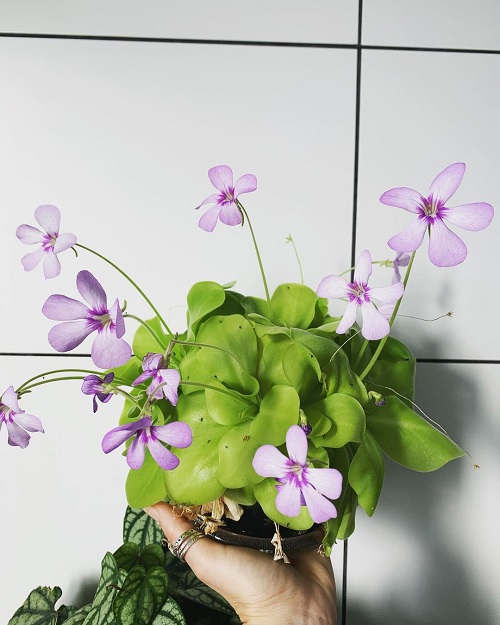
Growing Butterwort Plants In Pots
To cultivate butterwort plants successfully indoors, consider pot cultivation. Follow these steps for optimal growth:
- Selecting the Right Pot: Opt for a shallow pot with good drainage. A 4-inch diameter pot works well. Make sure it has drainage holes to prevent water accumulation.
- Soil Mix: Create a well-draining substrate by combining peat moss, perlite, and sand in equal parts. This mix mimics the butterwort’s natural habitat and aids in preventing root rot.
- Planting: Gently remove the butterwort from its nursery container, taking care not to damage the delicate roots. Place the plant in the pot’s center, allowing growth space.
- Light and Location: Place the pot in a bright location with indirect sunlight. A south-facing window with filtered light is ideal. Avoid direct sunlight, as it can scorch the leaves.
- Watering: Keep the soil consistently moist but not waterlogged. Water the plant from below by placing the pot in a saucer of water. This prevents water from touching the leaves, which are sensitive to moisture.
- Humidity: Maintain humidity levels by placing a shallow tray filled with water and pebbles near the plant. This creates a microclimate around the plant.
- Feeding: Butterworts are carnivorous and feed on insects. Allow the plant to catch its own prey or provide occasional feeding with small insects like fruit flies.
Check Out Ideas And Tips For Growing Carnivorous Plants In Containers Here
Growing Butterwort Plants In Hanging Baskets
For a unique display, consider cultivating butterwort your butterwort in hanging baskets. Follow these steps to grow it in hanging baskets:
- Basket Selection: Choose a hanging basket with good drainage and sufficient depth. A 5-6 inches diameter is recommended to accommodate the plant’s growth.
- Liner and Soil: Line the basket with sphagnum moss to retain moisture. Use a well-draining mix, such as a blend of peat moss and perlite, to create a supportive, growing environment.
- Plant Placement: Gently position the butterwort in the center of the basket, ensuring it’s secure. The leaves can cascade down the sides, creating an appealing arrangement. Ensure to avoid placing it near a windy place as it can affect the plant’s growth.
- Light Conditions: Hang the basket in a location with bright, filtered sunlight. A balcony or porch with indirect light is suitable. Ensure to avoid the harsh midday sun.
- Watering Approach: Water the plant thoroughly, allowing excess water to drain. Ensure the moss lining remains consistently damp but not soggy.
- Feeding and Prey Capture: Butterworts in hanging baskets can still capture prey. Insects naturally attracted to the plant will find their way into the basket.
Butterwort Plant FAQs
1. Can I grow butterwort indoors?
Absolutely! Butterworts can thrive indoors with the right care. Provide them with bright, indirect light, high humidity, and suitable temperatures to create an ideal environment for their growth.
Check Out Everything About Growing Malanga Plant Here
2. How often should I water my butterwort?
Water your butterwort regularly to keep the soil consistently moist. However, ensure the pot has proper drainage to prevent waterlogging, which can lead to root rot.
3. Do butterworts need fertilizer?
Butterworts do not require traditional fertilizers. They obtain nutrients from insects. Feeding insects once a week provides them with the necessary nutrients for healthy growth.



